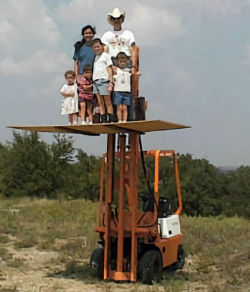Falling: Truth and Consequences
Why Fall Protection
Ever since we began working above ground level, falls have been among the most common causes of serious injuries and deaths.

As the photo illustrates, some people just don't understand fall hazards. Consequently they do things at work and home that defy good sense. The information in this course will help alert and prevent workers from falls.
We all need fall protection because even those of us with years of experience working at heights can suddenly lose our balance or grip and fall. We may think that our reflexes are fast enough to protect us, but even if we have great balancing and motor skills, and when we're distracted, we're at risk of falling.
OSHA Consequences
We usually don't emphasize working safely just to comply with OSHA regulations, but you need to realize that violations in OSHA's fall protection rules is on their radar every time they drive by a construction site. It's one of the most common, obvious, and easily observed violations. Think about it, you're working at elevation, visible to everyone on and off the worksite. If OSHA drives by and observes a worker violating fall protection rules, the inspectors have authority to stop and conduct a comprehensive no-notice inspection, and they will cite other violations as well. See the real-life accident below as an example.
Employer exposes workers to potentially fatal falls.
"At this worksite, OSHA inspectors observed eight workers exposed to falls of up to 20 feet due to lack of fall protection, employee training, an improperly erected scaffold and failure to have a competent person inspect the jobsite to identify and correct hazards," added Mulligan. "The employer's violations left its workers one slip, trip or misstep away from a potentially fatal incident."
Specifically, OSHA inspected in response to an employee complaint that roofing workers were not using fall protection. OSHA opened a comprehensive inspection and also found that the employer failed to:
- Provide fall protection for employees exposed to a 20-foot fall hazard.
- Train employees about fall hazards.
- Ensure ladders were extended at least 3 feet above the upper landing surface for stability and employees did not carry loads while using ladders.
- Ensure a ladder jack scaffold that lacked fall protection was erected by a competent person and the ladders supporting the scaffold were properly angled and secured.
- Have a competent person conduct frequent and regular inspections of the jobsite to identify and correct hazards.
- Provide employees with hard hats and eye protection.
- Provide inspectors with OSHA 300 illness and injury logs within four business hours.
The employer faces over $306,000 in penalties following an OSHA inspection.
Knowledge Check Choose the best answer for the question.
1-1. Why does every employee working at heights need fall protection?
You forgot to answer the question!

